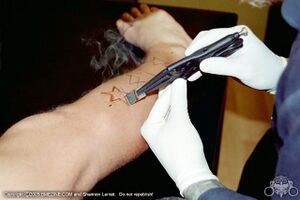Strike branding
Strike branding is the most common and most traditional form of branding. It is done by applying a piece of heated metal to the skin to burn tissue and form a scar. These brands can be done with a single or a series of strikes.
Tools
Strike brand utensils are metal, either as complete tools, or as small shaped pieces held in vice-grips. Metal holds the heat well, and effectively and quickly (and predictably) transfers it to the skin.
Most artists choose to make their branding tools out of thin, high-grade stainless steel sheet metal. That said, other materials such as silver, random metal findings (bolts, etc.), and even ceramics have been used. Metal allergies and bio-compatibility does come into play to some extent, but, in general, any foreign substances will come off with the scab (if they're even transferred at all).
As far as the thickness of the metal, thinner is usually better. It's easy to heat, easy to form, and only carries a limited amount of potential damage (whereas a red-hot 1/2" bolt can do enormous damage if held against the skin for too long). Remember as well, a brand will typically heal to three or four times as thick as the utensil, and usually never be thinner than 3/16" (about the same as the line drawn by a fat magic marker).
Usually, a brand will heal to three or four times the width of the utensil used to make it. So, if one uses an initial brander (which creates quite tiny letter), the final product will just be a blob. A brand should be large and simple enough that it compensates for spreading. You'll get the same results if you just put a cigarette out on yourself (don't do that).
The whole brand is not done as a single brand. The design is divided up into many smaller sections no larger than about an inch and a half. These smaller sections may be shaped of course (i.e. arcs instead of lines). It should be noted that a small area of skin is enclosed in branded tissue (for example a small circular outline brand), it will probably die as well and become part of the scar (as it can lose it's blood supply).
The tools must be hot enough to do sufficient damage to the tissue so as to form a permanent scar. Depending on the person's skin and the individual style of the artist, it can be anything from a propane torch to a lowly candle to the natural flames of an oak fire pit. Most experienced artists lean toward a propane torch.
The brand is pressed in long enough to burn through all the surface skin. If this is not achieved, the client will be left with a lot of pain and blistering, and then either no scar, or a blotchy mess that barely resembles their design after healing. As far as how long and hard, this really depends on how much the material has been heated.
Most important though, is that all of the strikes are even in relation to the skin they're on as this will increase the chances of the brand looking uniform. It should be noted that as a brand is done, the skin in the area will contract, deforming the tissue and slightly changing the way following strikes are absorbed.
